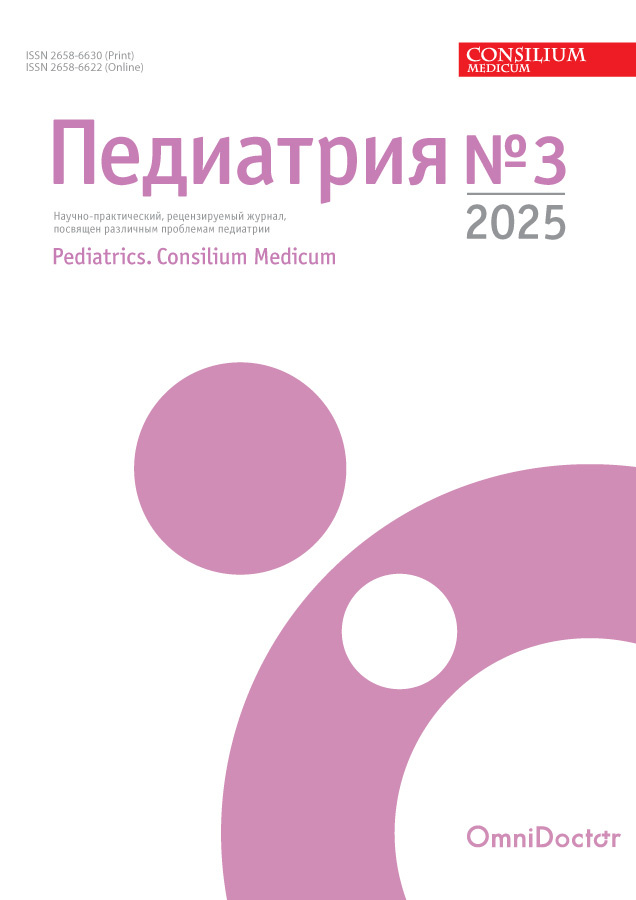Синдром гипербилирубинемии у детей раннего возраста. Разбор клинических случаев
- Авторы: Заплатников А.Л.1, Горяйнова А.Н.1, Дзядчик А.В.2, Коренькова О.В.2, Лаврова Т.Р.2, Любанская С.Ю.2, Россаус Е.В.2, Соложенцева А.Г.2, Стоногин С.В.2
-
Учреждения:
- Российская медицинская академия непрерывного профессионального образования
- Детская городская клиническая больница им. З.А. Башляевой
- Выпуск: № 3 (2025)
- Страницы: 214-221
- Раздел: Статьи
- URL: https://pediatria.orscience.ru/2658-6630/article/view/686630
- DOI: https://doi.org/10.26442/26586630.2025.3.203359
- ID: 686630
Цитировать
Полный текст
Аннотация
До настоящего времени неонатальные желтухи ставят перед врачом-педиатром и неонатологом много вопросов. Учитывая, что в последние десятилетия изменились сроки выписки новорожденных из родильного дома, врачу-педиатру первичного звена здравоохранения, и не только ему, приходится проводить дифференциальный диагноз между целым рядом причин, способных вызвать повышение билирубина и, как следствие, появление желтухи. Известны такие состояния, как желтуха здорового новорожденного (физиологическая и естественного вскармливания), желтуха, обусловленная гемолизом, нарушением печеночного клиренса билирубина, аномалиями развития билиарного тракта, врожденными нарушениями метаболизма, инфекционно-воспалительными заболеваниями печени. В любом случае врачу-педиатру важно разобраться, является ли желтуха следствием заболевания, угрожающего жизни ребенка, или нет. К сожалению, до настоящего времени приходится сталкиваться с ошибками, которых можно избежать при соблюдении простых рекомендаций и использовании методов обследования, которые являются рутинными и не требуют материальных затрат. На наших клинических примерах разберем основные проблемы неонатальных желтух.
Полный текст
Об авторах
Андрей Леонидович Заплатников
Российская медицинская академия непрерывного профессионального образования
Email: alex.goriaynowa@yandex.ru
ORCID iD: 0000-0003-1303-8318
д-р мед. наук, проф., зав. каф. неонатологии им. проф. В.В. Гаврюшова, проф. каф. педиатрии им. акад. Г.Н. Сперанского
Россия, МоскваАлександра Никитична Горяйнова
Российская медицинская академия непрерывного профессионального образования
Автор, ответственный за переписку.
Email: alex.goriaynowa@yandex.ru
ORCID iD: 0009-0009-9339-4152
канд. мед. наук, доц. каф. педиатрии им. акад. Г.Н. Сперанского
Россия, МоскваАлександр Валерьевич Дзядчик
Детская городская клиническая больница им. З.А. Башляевой
Email: alex.goriaynowa@yandex.ru
ORCID iD: 0000-0002-6751-3068
зав. хирургическим отд-нием №1 (гнойной хирургии), врач – детский хирург
Россия, МоскваОльга Валентиновна Коренькова
Детская городская клиническая больница им. З.А. Башляевой
Email: alex.goriaynowa@yandex.ru
ORCID iD: 0000-0001-6569-7409
врач – детский хирург хирургического отд-ния №1 (гнойной хирургии)
Россия, МоскваТатьяна Романовна Лаврова
Детская городская клиническая больница им. З.А. Башляевой
Email: alex.goriaynowa@yandex.ru
зав. отд-нием ультразвуковой диагностики
Россия, МоскваСветлана Юрьевна Любанская
Детская городская клиническая больница им. З.А. Башляевой
Email: alex.goriaynowa@yandex.ru
врач – детский хирург терапевтического отд-ния
Россия, МоскваЕвгения Владиславовна Россаус
Детская городская клиническая больница им. З.А. Башляевой
Email: alex.goriaynowa@yandex.ru
врач-неонатолог
Россия, МоскваАлла Григорьевна Соложенцева
Детская городская клиническая больница им. З.А. Башляевой
Email: alex.goriaynowa@yandex.ru
врач-педиатр
Россия, МоскваСергей Васильевич Стоногин
Детская городская клиническая больница им. З.А. Башляевой
Email: alex.goriaynowa@yandex.ru
ORCID iD: 0000-0003-3531-5849
канд. мед. наук, врач – детский хирург хирургического отд-ния №1 (гнойной хирургии)
Россия, МоскваСписок литературы
- Захарова И.Н., Горяйнова А.Н., Пыков М.И., и др. Желтухи у новорожденных и детей раннего возраста. Учеб. пособие. М.: ФГБОУ ДПО РМАПО, 2016 [Zakharova IN, Goriainova AN, Pykov MI, et al. Zheltukhi u novorozhdennykh i detei rannego vozrasta. Ucheb. posobie. Moscow: FGBOU DPO RMAPO, 2016 (in Russian)].
- Дементьева Г.М., Вельтищев Ю.Е. Профилактика нарушений адаптации и болезней новорожденных. Лекция для врачей. М., 1998 [Dement'eva GM, Vel'tishchev IuE. Profilaktika narushenii adaptatsii i boleznei novorozhdennykh. Lektsiia dlia vrachei. Moscow, 1998 (in Russian)].
- Шерлок Ш., Дули Дж. Заболевания печени и желчных путей. Пер с англ. М.: ГЭОТАР Медицина, 1999 [Sherlok Sh, Duli Dzh. Zabolevaniia pecheni i zhelchnykh putei. Per s angl. Moscow: GEOTAR Meditsina, 1999 (in Russian)].
- Alistair GSP. Neonatology. 2nd Ed. New York: Medical Examination Pub. Co., 1980.
- Alkalay AL, Simmons CF. Hyperbilirubinemia Guidelines in Newborn Infants. Pediatrics. 2005;115(3):824-5. doi: 10.1542/peds.2004-2442
- Bhutani VK, Stark AR, Lazzeroni LC, et al.; Initial Clinical Testing Evaluation and Risk Assessment for Universal Screening for Hyperbilirubinemia Study Group. Predischarge screening for severe neonatal hyperbilirubinemia identifies infants who need phototherapy. J Pediatr. 2013;162(3):477-82.e1. doi: 10.1016/j.jpeds.2012.08.022
- Kaplan M, Bromiker R, Hammerman C. Severe neonatal hyperbilirubinemia and kernicterus: Are these still problems in the third millennium? Neonatology. 2011;100(4):354-62. doi: 10.1159/000330055
- Moyer V, Freese DK, Whitington PF, et al.; North American Society for Pediatric Gastroenterology, Hepatology and Nutrition. Guideline for the evaluation of cholestatic jaundice in infants: recommendations of the North American Society for Pediatric Gastroenterology, Hepatology and Nutrition. J Pediatr Gastroenterol Nutr. 2004;39(2):115-28. doi: 10.1097/00005176-200408000-00001
- Memon N, Weinberger BI, Hegyi T, Aleksunes LM. Inherited disorders of bilirubin clearance. Pediatr Res. 2016;79(3):378-86. doi: 10.1038/pr.2015.247
- Muchowski KE. Evaluation and treatment of neonatal hyperbilirubinemia. Am Fam Physician. 2014;89(11):873-8. PMID: 25077393
- Maruo Y, Morioka Y, Fujito H, et al. Bilirubin uridine diphosphate-glucuronosyltransferase variation is a genetic basis of breast milk jaundice. J Pediatr. 2014;165(1):36-41.e1. doi: 10.1016/j.jpeds.2014.01.060
- Камышников В.С. Норма в лабораторной медицине. Справочник. М.: МЕДпресс-информ, 2014 [Kamyshnikov VS. Norma v laboratornoi meditsine. Spravochnik. Moscow: MEDpress-inform, 2014 (in Russian)].
- Горяйнова А.Н. Этюд в горчичных тонах. Statuspraesens. Педиатрия и неонатология. 2021;4:39-45 [Goriainova AN. Etyud v gorchichnyh tonah. Statuspraesens. Pediatriya i neonatologiya. 2021;4:39-45 (in Russian)].
Дополнительные файлы


















